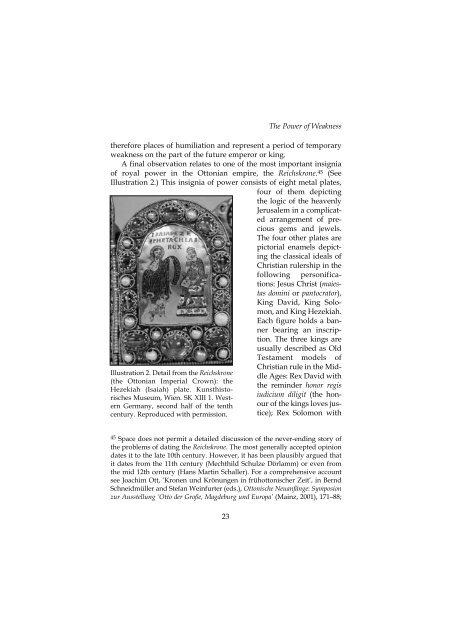The Power of Weakness: Machiavelli Revisited - German Historical ...
The Power of Weakness: Machiavelli Revisited - German Historical ...
The Power of Weakness: Machiavelli Revisited - German Historical ...
You also want an ePaper? Increase the reach of your titles
YUMPU automatically turns print PDFs into web optimized ePapers that Google loves.
therefore places <strong>of</strong> humiliation and represent a period <strong>of</strong> temporary<br />
weakness on the part <strong>of</strong> the future emperor or king.<br />
A final observation relates to one <strong>of</strong> the most important insignia<br />
<strong>of</strong> royal power in the Ottonian empire, the Reichskrone. 45 (See<br />
Illustration 2.) This insignia <strong>of</strong> power consists <strong>of</strong> eight metal plates,<br />
Illustration 2. Detail from the Reichs krone<br />
(the Ottonian Imperial Crown): the<br />
Heze kiah (Isaiah) plate. Kunst hi sto -<br />
risches Museum, Wien. SK XIII 1. West -<br />
ern Ger many, second half <strong>of</strong> the tenth<br />
century. Re pro duced with permission.<br />
23<br />
<strong>The</strong> <strong>Power</strong> <strong>of</strong> <strong>Weakness</strong><br />
four <strong>of</strong> them depicting<br />
the logic <strong>of</strong> the heavenly<br />
Je ru salem in a complicated<br />
arrangement <strong>of</strong> precious<br />
gems and jewels.<br />
<strong>The</strong> four other plates are<br />
pictorial enamels depicting<br />
the classical ideals <strong>of</strong><br />
Christian rulership in the<br />
following personifications:<br />
Jesus Christ (maiestas<br />
domini or pantocrator),<br />
King David, King Solo -<br />
mon, and King Heze kiah.<br />
Each figure holds a banner<br />
bearing an in scrip -<br />
tion. <strong>The</strong> three kings are<br />
usually described as Old<br />
Tes tament models <strong>of</strong><br />
Chris tian rule in the Mid -<br />
dle Ages: Rex David with<br />
the reminder honor regis<br />
iudicium diligit (the honour<br />
<strong>of</strong> the kings loves justice);<br />
Rex Solomon with<br />
45 Space does not permit a detailed discussion <strong>of</strong> the never-ending story <strong>of</strong><br />
the problems <strong>of</strong> dating the Reichskrone. <strong>The</strong> most generally accepted opinion<br />
dates it to the late 10th century. However, it has been plausibly argued that<br />
it dates from the 11th century (Mechthild Schulze Dörlamm) or even from<br />
the mid 12th century (Hans Martin Schaller). For a comprehensive account<br />
see Joachim Ott, ‘Kronen und Krönungen in frühottonischer Zeit’, in Bernd<br />
Schneidmüller and Stefan Weinfurter (eds.), Ottonische Neuanfänge: Symposion<br />
zur Ausstellung ‘Otto der Große, Magdeburg und Europa’ (Mainz, 2001), 171–88;













